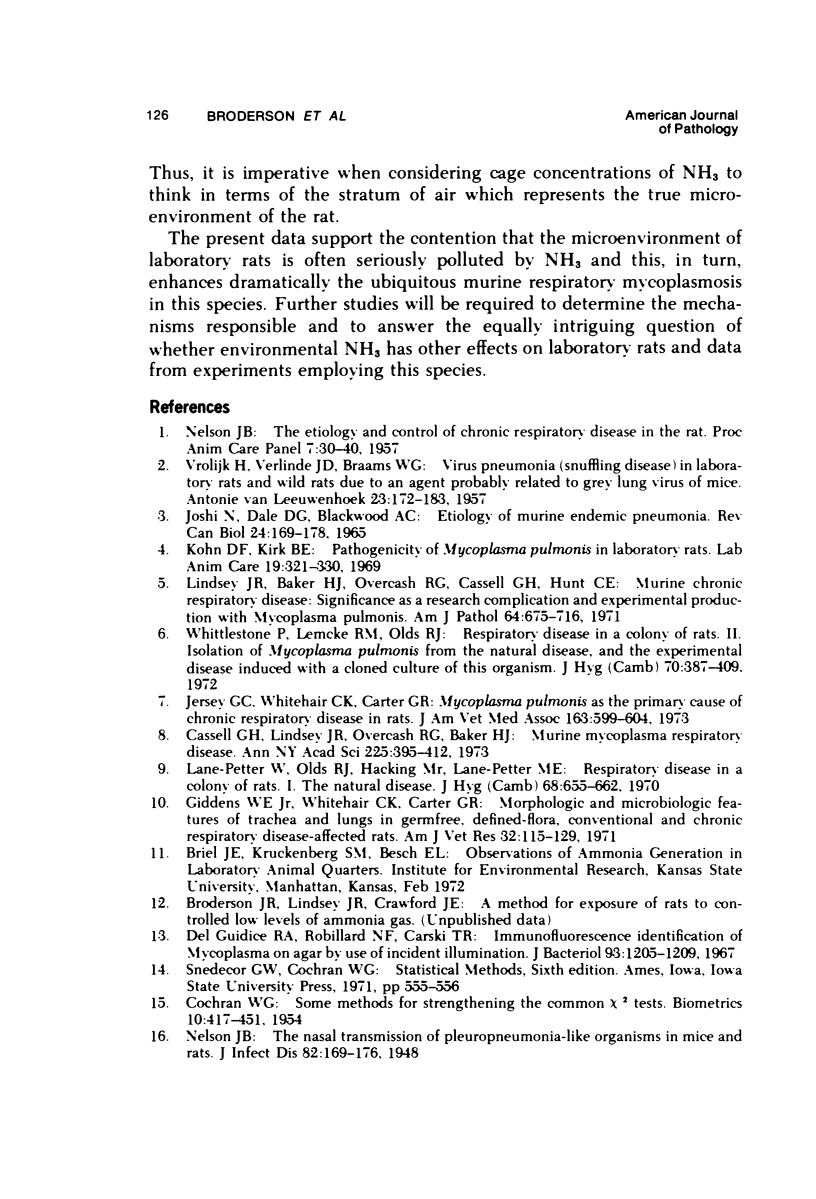Abstract
Young adult, pathogen-free rats of Sherman and Fischer (F344) substrains were inoculated intranasally with 10(8) colony-forming units (GFU) of M. pulmonis and housed for 4 to 6 weeks in environments with ammonia maintained at specific concentrations from 25 to 250 ppm. All levels of NH3--whether produced naturally from soiled bedding or derived from a purified source--significantly increased the severity of the rhinitis, otitis media, tracheitis, and pneumonia (including bronchiectasis) characteristic of murine respiratory mycoplasmosis (MRM). The prevalence of pneumonia, but not that of other respiratory lesions of MRM, showed a strong tendency to increase directly with environmental NH3 concentration. In contrast, NH3 exposure of rats not infected with M. pulmonis caused anatomic lesions that were unlike those of MRM and were limited to the nasal passages. It was concluded that environmental NH3, at concentrations commonly encountered in present day cage environments for rats, plays an important role in pathogenesis of MRM.
Full text
PDF















Images in this article
Selected References
These references are in PubMed. This may not be the complete list of references from this article.
- Anderson D. P., Wolfe R. R., Cherms F. L., Roper W. E. Influence of dust and ammonia on the development of air sac lesions in turkeys. Am J Vet Res. 1968 May;29(5):1049–1058. [PubMed] [Google Scholar]
- Charles D. R., Payne C. G. The influence of graded levels of atmospheric ammonia on chickens. II. Effects on the performance of laying hens. Br Poult Sci. 1966 Jul;7(3):189–198. doi: 10.1080/00071668608415623. [DOI] [PubMed] [Google Scholar]
- DALHAMN T. Mucous flow and ciliary activity in the trachea of healthy rats and rats exposed to respiratory irritant gases (SO2, H3N, HCHO): a functional and morphologic (light microscopic and electron microscopic) study, with special reference to technique. Acta Physiol Scand Suppl. 1956;36(123):1–161. [PubMed] [Google Scholar]
- Del Giudice R. A., Robillard N. F., Carski T. R. Immunofluorescence identification of Mycoplasma on agar by use of incident illumination. J Bacteriol. 1967 Apr;93(4):1205–1209. doi: 10.1128/jb.93.4.1205-1209.1967. [DOI] [PMC free article] [PubMed] [Google Scholar]
- Doig P. A., Willoughby R. A. Response of swine to atmospheric ammonia and organic dust. J Am Vet Med Assoc. 1971 Dec 1;159(11):1353–1361. [PubMed] [Google Scholar]
- Giddens W. E., Jr, Whitehair C. K., Carter G. R. Morphologic and microbiologic features of trachea and lungs in germfree, defined-flora, conventional, and chronic respiratory disease-affected rats. Am J Vet Res. 1971 Jan;32(1):115–129. [PubMed] [Google Scholar]
- Jersey G. C., Whitehair C. K., Carter G. R. Mycoplasma pulmonis as the primary cause of chronic respiratory disease in rats. J Am Vet Med Assoc. 1973 Sep 15;163(6):599–604. [PubMed] [Google Scholar]
- Joshi N., Dale D. G., Blackwood A. C. Etiology of murine endemic pneumonia. Rev Can Biol. 1965 Sep;24(3):169–178. [PubMed] [Google Scholar]
- Kohn D. F., Kirk B. E. Pathogenicity of Mycoplasma pulmonis in laboratory rats. Lab Anim Care. 1969 Jun;19(3):321–330. [PubMed] [Google Scholar]
- Lane-Petter W., Olds R. J., Hacking M. R., Lane-Petter M. E. Respiratory disease in a colony of rats. I. The natural disease. J Hyg (Lond) 1970 Dec;68(4):655–662. doi: 10.1017/s0022172400042595. [DOI] [PMC free article] [PubMed] [Google Scholar]
- Lindsey J. R., Baker H. J., Overcash R. G., Cassell G. H., Hunt C. E. Murine chronic respiratory disease. Significance as a research complication and experimental production with Mycoplasma pulmonis. Am J Pathol. 1971 Sep;64(3):675–708. [PMC free article] [PubMed] [Google Scholar]
- Murakami H. Differences between internal and external environments of the mouse cage. Lab Anim Sci. 1971 Oct;21(5):680–684. [PubMed] [Google Scholar]
- Sato S., Shoya S., Kobayashi H. Effect of ammonia on Mycoplasma gallisepticum infection in chickens. Natl Inst Anim Health Q (Tokyo) 1973 Summer;13(2):45–53. [PubMed] [Google Scholar]
- VROLIJK H., VERLINDE J. D., BRAAMS W. G. Virus pneumonia (snuffling disease) in laboratory rats and wild rats due to an agent probably related to grey lung virus of mice. Antonie Van Leeuwenhoek. 1957;23(2):172–183. [PubMed] [Google Scholar]
- Whittlestone P., Lemcke R. M., Olds R. J. Respiratory disease in a colony of rats. II. Isolation of Mycoplasma pulmonis from the natural disease, and the experimental disease induced with a cloned culture of this organism. J Hyg (Lond) 1972 Sep;70(3):387–407. doi: 10.1017/s0022172400062975. [DOI] [PMC free article] [PubMed] [Google Scholar]






